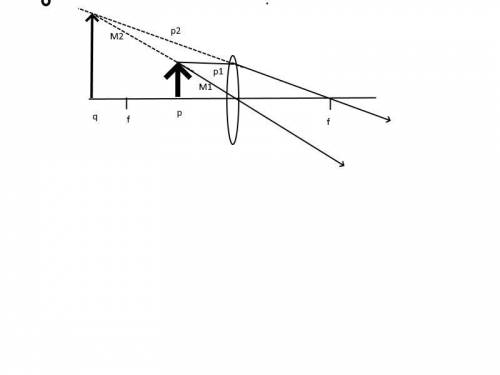
Now consider the case in which the object is between the lens and the focal point. Trace the P ray (use the label P1P1P_1 for the segment of the P ray on the same side as the object and P2P2P_2 for the segment on the opposite side) and the M ray. Draw the vectors for the incident rays starting from the tip of the object. The location and orientation of the vectors will be graded.

Answers: 3
Another question on Physics

Physics, 22.06.2019 05:00
Aperson stands on a platform, initially at rest, that can rotate freely without friction. the moment of inertia of the person plus the platform is ip. the person holds a spinning bicycle wheel with its axis horizontal. the wheel has moment of inertia iw and angular velocity ωw. take the ωw direction counterclockwise when viewed from above. part a what will be the angular velocity ωp of the platform if the person moves the axis of the wheel so that it points vertically upward?
Answers: 1

Physics, 22.06.2019 07:30
Some material consisting of a collection of microscopic objects is kept at a high temperature. a photon detector capable of detecting photon energies from infrared through ultraviolet observes photons emitted with energies of 0.3 ev, 0.5 ev, 0.8 ev, 2.0ev, 2.5ev, and 2.8ev. these are the only photon energies observed. (a) draw and label a possible energy-level diagram for one of the microscopic objects, which has four bound states. on the diagram, indicate the transitions corresponding to the emitted photons. explain briefly. (b) would a spring–mass model be a good model for these microscopic objects? why or why not? (c) the material is now cooled down to a very low temperature, and the photon detector stops detecting photon emissions. next, a beam of light with a continuous range of energies from infrared through ultraviolet shines on the material, and the photon detector observes the beam of light after it passes through the material. what photon energies in this beam of light are observed to be significantly reduced in intensity (“dark absorption lines”)? explain briefly.
Answers: 3

Physics, 22.06.2019 12:10
Ablock having mass m slides down an inclined plane. the force of friction between the block and the inclined plane is f, the block's weight is m g, and the normal force is n. (a) draw a free – body force diagram showing the forces acting on the block. (b) write down all relevant newton’s equations for a given situation.
Answers: 1

Physics, 22.06.2019 20:00
In an old-fashioned amusement park ride, passengers stand inside a 3.0-m-tall, 5.0-m-diameter hollow steel cylinder with their backs against the wall. the cylinder begins to rotate about a vertical axis. then the floor on which the passengers are standing suddenly drops away! if all goes well, the passengers will “stick” to the wall and not slide. clothing has a static coefficient of friction against steel in the range 0.60 to 1.0 and a kinetic coefficient in the range 0.40 to 0.70. part a what is the minimum rotational frequency, in rpm, for which the ride is safe? express your answer using two significant figures. f f = rpm
Answers: 1
You know the right answer?
Now consider the case in which the object is between the lens and the focal point. Trace the P ray (...
Questions

Biology, 12.10.2020 01:01

Mathematics, 12.10.2020 01:01

History, 12.10.2020 01:01


Mathematics, 12.10.2020 01:01


Mathematics, 12.10.2020 01:01




Mathematics, 12.10.2020 01:01

Mathematics, 12.10.2020 01:01

Arts, 12.10.2020 01:01

Mathematics, 12.10.2020 01:01

English, 12.10.2020 01:01

Arts, 12.10.2020 01:01

History, 12.10.2020 01:01






